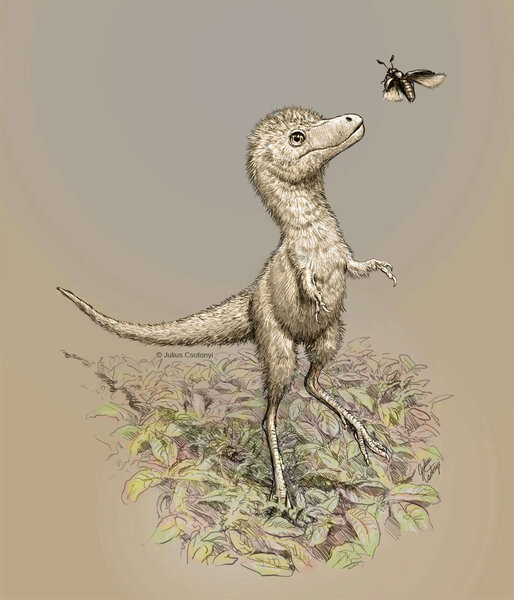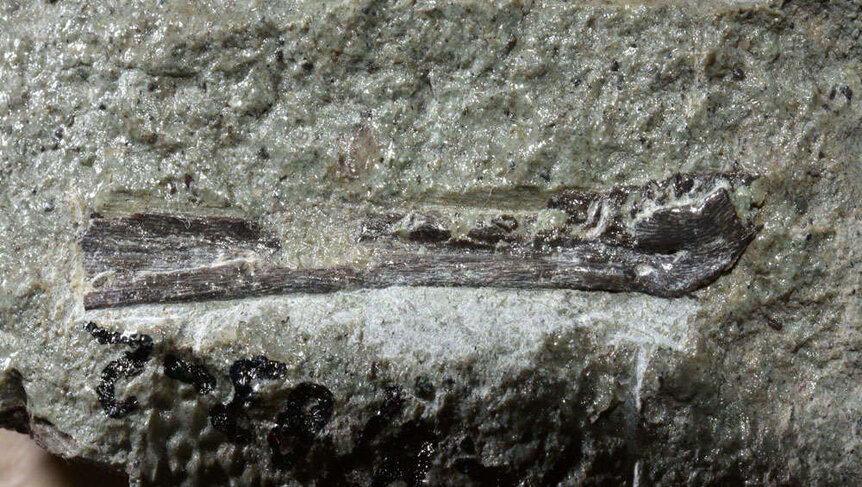Create a free profile to get unlimited access to exclusive videos, sweepstakes, and more!
So apparently a baby tyrannosaurs was deceptively adorable, but still deadly

Tyrannosaurs — literally “tyrant lizards” and cousins of the infamous T. Rex — could be cute in some sort of way when they hatched, so long as they didn’t bite your head off.
Even baby flesh-eating dinosaurs must have still been kind of adorable if you ignored the lethal teeth. The first fossils belonging to a tyrannosaur embryo, a tiny claw and jawbone, have been unearthed, finally giving us an idea of what these behemoths might have looked like when they hatched. More recent 3D scans revealed that the embryos, which may have been the unhatched offspring of an Albertosaurus, were ginormous babies. At 3 feet long, they are now the largest hatchlings ever known. They also looked like mini adults.
“What we find is that tyrannosaur embryos would have been the largest hatchlings to ever emerge from an egg, and so they must have had enormous eggs,” paleontologist Gregory Funston, who led a study recently published in Canadian Journal of Earth Sciences, told SYFY WIRE. “Our embryo is even larger than that of an Elephant Bird, which had the largest eggs (by volume) of any animal.”
Now extinct, the Aepyomis or elephant bird could make an ostrich look like a chicken. This thousand-pound beast stood 10 feet tall and was believed to be the largest bird that ever roamed the planet. Its eggs were about a foot long, 28 inches around and had the volume of 150 chicken eggs. Whatever tyrannosaur species this embryo belonged to was also larger than those of Macroelongatoolithus, the dinosaur which held the record for the longest known eggs (and one of the longest names) until now. The eggs of this nearly unpronounceable dinosaur were 17 inches long, but the embryo Funston and his team examined was larger than the ones preserved inside those eggs.
Most tyrannosaurs must have laid monstrous eggs if they were to beat elephant birds and that dinosaur who (almost) must not be named.
It was surprising to Funston that these babies mirrored their parents so much. Until now, only teenage and adult tyrannosaurs have been studied, so there has been limited knowledge on how they began life at the top of the food chain. Studies of T. Rex have found out that the most noticeable difference between the teenagers and adults was that teen tyrants were much more quick and slender until they grew into their huge, lumbering adult frame. Adults may have not gotten around as fast, but their bone-crushing heads and heavy frames were more than enough to be instant doom to an unassuming victim as they sank teeth the size of bananas into its flesh.
“We were quite struck by how similar the lower jaw was to those of other juvenile and adult tyrannosaurs,” he said. “We know from previous work that some of the proportions and features of the skeletons changed over time, but our bones show that, for the most part, tyrannosaur babies would have been recognizable as tyrannosaurs.”
What makes the obviousness of these fossils so exciting is that they will make it easier to identify any that may surface in the future, and maybe even previously mislabeled tyrannosaur embryos or babies that are and just waiting to be found hanging out in the dusty back room of some museum. They might even be hiding on display. If there was a dino-sized controversy over a juvenile T. Rex mistaken for a new species and called Nanotyrannus for years, it can happen.
The tyrannosaur that never got a chance at life has now hatched new insights and questions that were lost to time for 66-85 million years. Something that is not well known about tyrannosaurs is their nesting habits. There is one thing that this embryo has revealed, which is that its parents were nesting with other species of dinosaurs, even they did eat some of them. No other evidence of tyrannosaur eggs or embryos has been found at a nesting site before. Whether there were that many of these theropods laying their eggs in one area is still a mystery. Were few of them around, or could it have been something else?
“This is possibly just because tyrannosaurs weren’t very common in their ecosystems, but we also speculate that it could relate to the kinds of eggs tyrannosaurs were laying,” said Funston. “Some recent studies show that many dinosaurs laid soft-shelled eggs, and if this was the case for tyrannosaurs, it might explain the rarity of their eggs and embryos.”
More questions emerged with the embryo, though according to Funston, they are questions that couldn’t even be asked without a fossil to spawn them. He and his team are now working on finding out how long tyrannosaurs would develop in the egg before they finally busted out, which might be hiding in lines that formed on its teeth as it grew. Because its jaw was eerily similar to a teen tyrannosaur’s, though with less power to smash the bones of prey, he also wants to see whether these babies had the bite they needed to hunt on their own as soon as possible.
“Tyrannosaur babies may have been born with the tools they needed to be competent hunters,” he said. “This is called a precocial lifestyle, and it would help to give us a sense of how much tyrannosaur parents were caring for their young.”
What we do know about tyrannosaur babies is that they grew up into slow-moving stalkers that depended on their bulk for an ambush attack. Though they were vicious predators, theropods of this size went for massive prey that couldn’t really make a run for it. Albertosaurus is thought to have been only slightly smaller than its more famous relative, so it probably wasn’t much faster. Jurassic Park had the speed of a full-grown T. Rex wrong. There is no way a creature that is thought to have moved at about 10-12 miles an hour could chase down a car going 40 mph. It wasn’t worth the effort when there were so many delicious sauropods nearby.
The only thing the movie got right were the thundering footsteps of something so heavy. That, and the creepy cuteness of dinosaur hatchlings, even if those were velociraptors.




























